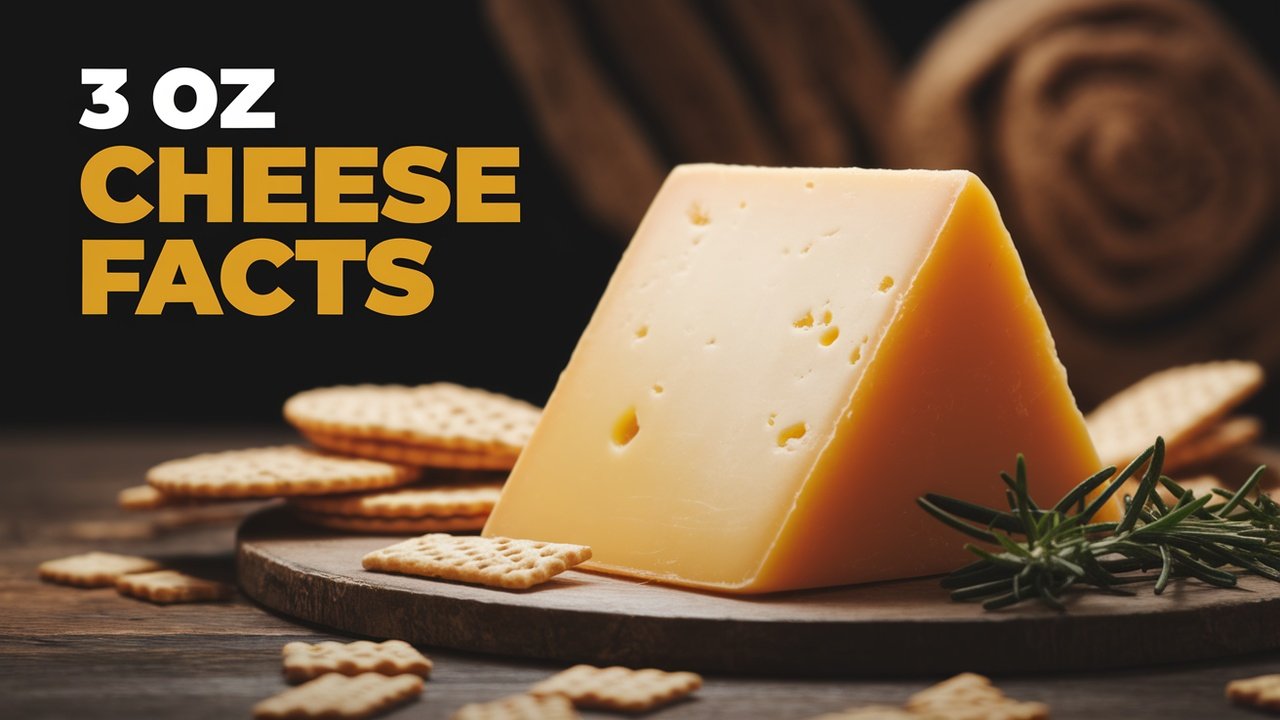Everything You Need to Know About 3 oz of Cheese: Nutrition, Uses, and More

Introduction
Cheese is a beloved dairy product enjoyed around the world, adding flavor and texture to countless dishes. Whether sprinkled over pasta, layered in a sandwich, or eaten as a snack, cheese is a versatile ingredient packed with protein, calcium, and essential nutrients.
But when it comes to portion control and nutrition, understanding exactly how much 3 oz of cheese represents can be important for diet planning and recipe accuracy.
This article explores everything about 3 oz of cheese, including its nutritional breakdown, how to measure it without a scale, different types of cheese and their calorie content, and the best ways to use this portion in everyday meals.
How Much Is 3 oz of Cheese?
Visual Representation
For those who don’t have a kitchen scale, measuring cheese can be tricky. Here’s a general guide to estimating 3 oz of cheese:
- Blocks of Cheese – A standard cheese block size varies, but 3 oz is roughly equivalent to three standard slices or about the size of a deck of cards.
- Shredded Cheese – If using shredded cheese, 3 oz is approximately 1 cup (loosely packed).
- Cheese Cubes – If cubed, 3 oz is about 9 to 12 small cubes, depending on the cheese type.
- Slices – For pre-packaged cheese slices, 3 oz is usually 3 to 4 slices, depending on thickness.
Nutritional Value of 3 oz of Cheese

Cheese varies in nutritional content based on the type. Below is a breakdown of the approximate nutritional values for 3 oz of common cheeses:
1. Cheddar Cheese
- Calories: 340 kcal
- Protein: 21g
- Fat: 28g
- Calcium: 600mg
2. Mozzarella Cheese
- Calories: 255 kcal
- Protein: 18g
- Fat: 18g
- Calcium: 500mg
3. Parmesan Cheese
- Calories: 330 kcal
- Protein: 30g
- Fat: 22g
- Calcium: 950mg
4. Swiss Cheese
- Calories: 320 kcal
- Protein: 24g
- Fat: 25g
- Calcium: 800mg
5. Cottage Cheese (Low-Fat, 1%)
- Calories: 60 kcal
- Protein: 10g
- Fat: 1.5g
- Calcium: 90mg
As seen above, 3 oz of cheese is a great source of protein and calcium, but it can also be high in fat and calories, depending on the type.
Health Benefits of Eating 3 oz of Cheese

1. Great Source of Protein
Cheese provides high-quality protein essential for muscle repair, immune function, and overall health.
2. Rich in Calcium
Calcium helps maintain strong bones and teeth, reducing the risk of osteoporosis.
3. Contains Healthy Fats
Many cheeses offer healthy fats that support brain function and provide long-lasting energy.
4. Supports Gut Health
Fermented cheeses like parmesan and blue cheese contain probiotics that promote gut health.
5. Provides Essential Vitamins
Cheese contains vitamins A, B12, and K2, all of which support vision, red blood cell formation, and cardiovascular health.
How to Incorporate 3 oz of Cheese into Your Diet
If you’re looking to enjoy 3 oz of cheese in a balanced way, here are some delicious ideas:
Breakfast
- Cheese Omelet – Mix 3 oz of shredded cheddar with eggs for a protein-packed breakfast.
- Cottage Cheese with Fruit – Pair 3 oz of cottage cheese with berries and honey for a refreshing start to your day.
Lunch
- Grilled Cheese Sandwich – Use 3 oz of Swiss or mozzarella for a delicious, melty sandwich.
- Salad Topping – Add 3 oz of feta or parmesan to boost your salad’s flavor.
Dinner
- Pasta with Cheese – Stir 3 oz of parmesan into pasta dishes for an umami-rich finish.
- Cheese-Stuffed Chicken Breast – Use 3 oz of mozzarella to stuff a chicken breast for a creamy, cheesy main course.
Snacks
- Cheese and Crackers – Pair 3 oz of cheddar with whole-grain crackers for a satisfying snack.
- Cheese and Nuts – Combine 3 oz of cheese cubes with almonds or walnuts for a nutrient-dense snack.
Choosing the Best Cheese for Your Diet
If you’re trying to maintain a healthy diet, consider the following:
Low-Calorie Options
- Cottage Cheese
- Ricotta (Part-Skim)
- Mozzarella (Part-Skim)
High-Protein Cheeses
- Parmesan
- Cheddar
- Swiss
Best for Lactose Sensitivity
- Aged Cheeses (Parmesan, Swiss, Gouda)
- Lactose-Free Cheeses (Certain brands offer lactose-free cheddar or mozzarella)
How to Store 3 oz of Cheese Properly
To maintain freshness and prevent spoilage:
- Refrigerate properly – Store cheese in an airtight container or wrap it in parchment paper before sealing it in plastic wrap.
- Freeze for longevity – Hard cheeses like cheddar and parmesan can be frozen for up to 6 months.
- Use within expiration date – Fresh cheeses like mozzarella or ricotta should be consumed within a week of opening.
Conclusion
Understanding 3 oz of cheese helps with portion control, nutrition awareness, and culinary creativity. Whether you are counting calories, looking for a protein boost, or just indulging in a delicious treat, knowing how to measure and incorporate cheese into your diet ensures you enjoy it in a balanced way.
With the right type of cheese, storage methods, and recipe ideas, you can make the most of 3 oz of cheese while maintaining a healthy and delicious lifestyle. So go ahead, grab your favorite cheese, and savor every bite!





